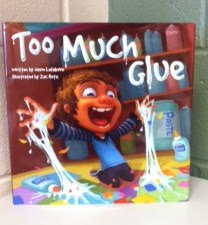Above is a photo of one of my favorite projects I completed during my years at Park University. The goal of the "game" was to generate original designs from base shapes. I chose to cross organic shapes with geometric shapes. I explained to my students that it worked kind of like a multiplication table. Overlapping, implying, hybrid-ing- all allowed! The kids were completely overwhelmed when I showed them mine, so I had to reassure them that theirs would be much less complex. So we started out by developing the game board below. I had to make a lot of adjustments based on the paper sizes. You really just need a 3x3 grid. I chose to walk through the whole process using the document camera. Older students could probably handle simple instructions on their own. (You would be surprised, though, at how poorly some 5th graders operate a ruler.)
We discussed the first two elements: line and shape before beginning this whole process. So, in the box in the upper left hand corner, I had them split it with the words GEOMETRIC and ORGANIC. We used boxy, staight-lined letters for geometric and bubbly, curvy letters for organic. Then, they were to develop two organic shapes for the top horizontal rows and two geometric shapes for the left hand column. From there, they generated four new designs that were the product of those original shapes crossing paths. They were encouraged to use scrap paper and the light box/window to layer tracings of their originals.


This is one of those that I am not entirely sure I would do again. I couldn't believe how much some kids struggled. They were mostly confused about what went where or how to creatively combine them. Sometimes they came up with really cool designs but I had to ask where they got them from because they definitely didn't follow my procedures. A handful from each class REALLY got it! Maybe with more time to experiment, they would have emraced the tracing and overlapping techniques, but that's what is hard about elementary specials classes- you don't see them enough to spend more than 2 or 3 periods on a project. My take away for this is that they learned how to make straight-lined grids with a ruler. They can never get enough practice using those tools! I would highly reccomend this project to anyone that teaches high school!


















